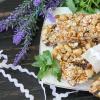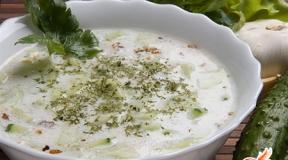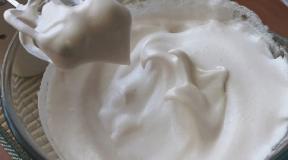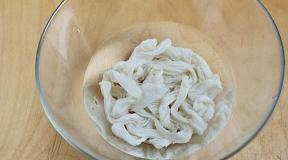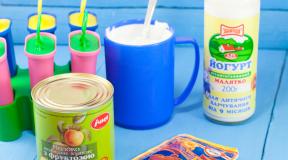Health lessons from Tibetan Mastiffs. Training and education of the Tibetan Mastiff Quiet during the day and dashing at night
Perhaps, not one breed in the world is surrounded by so many rumors, secrets and legends as huge mastiff-like dogs that have accompanied shepherds and wandering Buddhist monks for more than five thousand years.
Huge, with incredible physical strength and well-developed intellect, they were often not so much watchmen as loyal friends and family members of the indigenous population of Tibet.
Natural isolation and reverent attitude towards huge hairy friends of man made the Tibetan Mastiff a real one. dog legend, about which many have heard, but few have seen alive.
Plain dogs, found in Northern China and on the territory of the Gobi Desert, often interbred with guard dogs of alien merchants passing with caravans along the Great Silk Road, or with animals brought by travelers from distant countries - this is how the ancient aboriginal breeds bred by the local population became smaller and disappeared. thousands of years ago.
And only in hard-to-reach mountainous regions, where for centuries the foot of a stranger has not set foot, dogs of the purest blood have survived. Those from whom, according to legend, the molossians of Ancient Rome and the pickling dogs of Egypt originated were considered a real national treasure and for a long time did not surrender into the hands of strangers.
History of the origin of the breed
For the first time, Europe saw Tibetan Mastiffs in mid nineteenth century... It was then that Baron Harding, the future Viceroy of India, presented a young male mastiff to Queen Victoria. Four decades later, King Edward VII brought two more dogs of this breed to London.
The gigantic growth of mastiffs, thick hair and luxurious lion's mane caused bewilderment and even fright of ordinary Englishmen, who were not accustomed to such dogs.
Most progressive Londoners, including renowned zoological scientists, considered animals to be true wild beasts, whose place in a fenced-in cage. It was there, in the city zoo, that the only mastiffs in the civilized world lived for a long time, serving for the amusement of the public for many years and even bringing offspring in captivity.
External appearance
The height at the withers of a standard breed reaches 75 cm, the weight of the Tibetan Mastiff often exceeds 65 kg. Distinctive feature dogs of this breed are considered dense coat with a luxurious, densely padded undercoat... The unique density of hair leads to the fact that animals are not afraid of even forty-degree frosts, with pleasure resting right in the snow.
Unlike factory animals, aboriginal mastiffs molt only once a year- as a rule, this event takes place in late March - early April. A thick dense fur coat during this period needs especially careful care.
Breeders of the breed recommend thoroughly combing the pet out several times a day during this period, achieving a complete waste of dead wool. Fortunately, after a few days of hard work, all the troubles are settled, and for the rest of the time the dog's fur coat does not cause absolutely any trouble to the new owners.
Like most primitive breeds, Tibetan Mastiffs are considered dogs of late formation... Bitches grow up to 2.5-3 years old, and males do not finish development until the age of 4 years. Another interesting physiological fact is the ability to reproduce. Unlike most other dog breeds, a Tibetan Mastiff bitch is in heat only once a year, starting most often at the very beginning of winter.
Character
There are many legends about the protective qualities and devotion of the Tibetan mastiffs, attributing to them enormous physical strength and willingness to give his life for his family or the property of the owner. Much of what is said about these dogs is absolutely true.
This breed truly, like no other, is capable of miracles of dedication and determination in non-standard situations. Perceiving the owner not as an absolute leader, but rather as an equal partner, the Tibetan Mastiff believes that he himself has the right to make decisions about his own actions in the event of a threat.
Enormous physical strength it combines with fantastic swiftness and ease, allowing in a matter of seconds to catch up and neutralize the intruder at any end of the entrusted area. Natural cunning and high intelligence allowed dogs of this breed to act even against firearms. And, what is most interesting, in most cases, to emerge victorious in a fight with an armed man.
The disadvantage of such independence is that, confident in his own strength, the Tibetan Mastiff often tries to decide for himself who can and who cannot be allowed to his beloved master. Therefore, if you do not want to part with a long list of friends whom the mastiff "did not approve", obedience and strict adherence to commands should be brought up in this breed as early as possible.
Ruthlessness towards enemies combined with amazing tenderness to the household, and especially to the children of the owner. Ferocious watchdogs allow babies to do whatever they want with them, courageously enduring painful pinches or annoying harassment of little people. A condescending attitude towards children is a pedigree trait of the Tibetan Mastiff and has its roots in the distant past, when these stern fighters were entrusted with the most precious thing - defenseless kids, whom they guarded from wild animals and ill-wishers.
Another distinctive feature of this breed of dogs is phenomenal, telepathic connection with the owner. Able to subtly sense the mood, the mastiff, even behind closed doors, shows concern if the owner is upset or upset. In their homeland, these mystical dogs were often put to bed in the bedroom. It was believed that these animals have the ability to drive away evil night spirits and can even protect the owner from death, which, according to legend, chose its prey at midnight moonless.
Specific recognizable barking Mastiff was especially appreciated by fans of the breed. A deaf low voice, reminiscent of the blows of a copper gong, was considered a sign of purebredness, the special physical and spiritual strength of a pet. In order to give the sounds the desired tonality, the dog was often given warm buffalo milk to drink, giving the animal's barking timbre the desired velvety texture.
Those who decide to have this magnificent watchman at home should know that for a healthy, full-fledged life, the Tibetan Mastiff needs an open sky overhead and a fairly large area for unhindered walking... In a city apartment, the dog will very soon begin to wither, get sick and may even die of melancholy.
The harsh, full of hardships, the life of the ancestors left an imprint on the character of the animal. Dogs of this breed are amazing unpretentious in food... For millennia, the food of herding dogs in the mountains of Tibet has been barley chatter, lightly flavored with grated feta cheese. Since then, the heirs of the legendary guards have been rather restrained in their food, taking food in small quantities and only when they see fit to support their forces.
Former keepers of the herd, Tibetan Mastiffs loyal to other pets... Despite its enormous strength, a dog of this breed will never offend even the weakest chicken in the master's yard. But dogs are especially fond of the representatives of the feline tribe.
Owners should be prepared for the good-natured giant to take on the role of an older brother or become a caring nanny for tiny newborn kittens, and then, when the cat grows up, he will carefully look after a friend, slipping him the most delicious pieces or carefully licking the cat's fur.
ARD has already talked about, so in demand in nomadic animal husbandry. Now another story about the magnificent guards of our homes from the Naran Tibetan Medicine Clinic. It is believed that the Banhars were the ancestors of the Mastiffs.
The Tibetan Mastiff is the most expensive dog breed in the world, with individual members of this breed selling for US $ 1.5 million. Several years ago, the first Tibetan Mastiffs appeared in Russia. Today their popularity is growing rapidly: owners and breeders have appreciated the balanced character and good health of these dogs.
Many mystical stories are told about Tibetan Mastiffs. The peasants believed that the light eyebrows of this dog are the second pair of eyes, with the help of which the dogs manage to never sleep: when one pair of eyes is closed, the other is open. It was also believed that these second eyes of the Tibetan Mastiff are able to look directly into the soul of a person. The mastiff was revered as the dog of the Buddha: in China there is a legend that during the time of a terrible famine, the Buddha descended from heaven on a Tibetan mastiff and gave the emaciated people food.
The Tibetan Mastiff is an indigenous breed, that is, created by nature itself. Those animals that people bred deliberately through selection are susceptible to various diseases... Aboriginal breeds are distinguished by good immunity, long life expectancy and immunity to diseases.
Interacting with a Tibetan Mastiff can teach some of the rules that this dog follows intuitively. Observance of these rules is the secret of natural Tibetan health and longevity.
1. Calm, only calm!
The Tibetan Mastiff is the very embodiment of tranquility. Dogs can sit still for hours, as if meditating. On a walk with a Tibetan Mastiff, the owner will have to adapt to his calm pace. Even a hungry or delighted dog will not fuss: he will approach the owner with dignity, greet him in a friendly way. The manner of communication of these dogs is reminiscent of Tibetan monks: it is almost impossible to bring them out of mental equilibrium.
2. Silence is golden
Many representatives of this breed, especially males, rarely bark. The Tibetan owners, who for the first time faced the silence of the dog, run to the veterinarian, worrying if they got the dumb dog. The Tibetan Mastiff simply does not spend extra energy on barking. If nothing threatens the owner, everything is calm - why bark again? The Tibetan voice is unique: it is a low, metallic bass that echoes in the mountains. The mastiff considers it unworthy to breach such a voice in vain.
3. Quiet during the day and dashing at night
Tibetan Mastiffs have two different psychological states: day and night. Like all dogs, they do not have an extended sleep period once a day: they sleep for two to three hours as needed, then fall asleep again after a period of wakefulness. An awake dog behaves completely differently depending on the time of day. By day, the Tibetan Mastiff is a friendly dog, open to communication. He, of course, will protect his master if he feels a threat, but he will not just rush at passers-by.

On a day walk, the mastiff is sociable, gladly lets himself be stroked, without showing the slightest aggression. However, at night there comes a time when the mastiff feels like a defender of the territory. The name of this breed in Chinese - do-khyi - literally means "dog that is tied." During the day, the dogs sat at the peasants' huts, guarded the children and livestock. At night, they were left on free range, and any stranger who entered the territory, the Tibetan Mastiff immediately chased away. For this he did not even need to show his teeth: one powerful "gava" was enough for the intruder to get away. Peasants in Tibet believed that dogs turn into lions at night.
Changing the time of day also has a serious effect on a person: our body functions differently in sunlight and in darkness. By artificially prolonging daylight hours with the help of lamps, we deceive the body. Night vigils, exhausting work, lack of sleep undermine human health.
The Tibetan Mastiff, standing up to guard the house at nightfall, as if telling his master: calm down, it's my time, you can go to rest, I will be on my guard. Modern Tibetan mastiffs live, as a rule, in country houses, and at night they sleep outside the door of the house. The dog's fluffy coat allows him to be outside around the clock, even in severe frosts.
4. Moderation in everything
Despite its gigantic size, the Tibetan Mastiff eats little. He needs as much feed as german shepherd... Breeders warn owners that the puppies should never be overfed: the paws will not withstand the increasing body weight. Adult dogs are good at regulating hunger, and can leave food in the bowl if they have eaten enough. People have been training and educating dogs for many years, forgetting that a person himself can learn a lot from his pet. Dogs intuitively organize their lives and set an example for their owner. The majestic and balanced Tibetan Mastiff can teach a person a lot.
The Tibetan Mastiff breed is considered one of the oldest in the world. It takes its roots from Tibet - a mysterious and distant land. For a long time, representatives of this breed were not exported from the country: it is not that the laws forbade it, but rather the loss of the high mountainous regions played a role. At the same time, isolation has served well in terms of maintaining the purity of the breed and its unique character traits: strength, endurance, loyalty, independence, poise and others. These dogs do not care about difficult climatic conditions or a difficult lifestyle.
Description and characteristics (Photo)

- Country: Tibet
- The weight: 55-60 kg - female, 64-77 kg - male
- Height: 61 cm - female, 66 cm - male
- Sexual maturity: 3 years old female, 4 years old male
- Life Expectancy: 10-15 years old
- Structure: strong
- Proportions: body length is greater than height
- Bite: scissor, let's say straight
- Color: black or red with tan markings, a small white patch on the chest is allowed
- Wool: medium length, straight, coarse, fine, rich undercoat
- Group: pinschers, schnauzers, dog-like
- Application: sentry, guard dog, companion
- Recognized: FCI, RKF, AKS, SKS, KS
- Other names: do-khai (or do-hi), tibetan dog, tibetan moloss, tibetan dog
 The character of the Tibetan dog is stubborn and independent. She is smart and has an increased sense of self-esteem, has a developed intuition and requires increased attention from the owner.
The character of the Tibetan dog is stubborn and independent. She is smart and has an increased sense of self-esteem, has a developed intuition and requires increased attention from the owner. - Tibetan - companion, who loves souls in all members of his own "pack" - the owners, their children, their pets. However, he is extremely suspicious of outsiders. For centuries, the instincts of a guardian and protector, educated, can work even on adults or small guests of the owners, if the pet considers their behavior aggressive. True, if the dog is well-mannered (otherwise it is simply dangerous to keep him), he will obey the owner and will not interfere, but he will not lose vigilance, observing the events.
Playing with creatures different sizes, the Tibetan Mastiff easily measures his own strength with their weight and height and does not cross the dangerous line with children, cats and other "trifles", which they seem to him.

Did you know? The bark of the Tibetan Mastiff is unique, it is a particularly valuable characteristic of the breed. In Tibet, they were specially given warm milk to drink in order to preserve the thickness and velvety of the timbre, comparable to the sound of a copper gong.
 The Tibetan Mastiff is not suitable for everyone - its purpose is to guard and protect, and before starting it, you should carefully study the description of the breed and its features, communicate with the breed breeders and owners.
The Tibetan Mastiff is not suitable for everyone - its purpose is to guard and protect, and before starting it, you should carefully study the description of the breed and its features, communicate with the breed breeders and owners. The origin of the breed
There is a hypothesis that the Tibetan mastiffs, while retaining their original appearance, at the same time became the progenitors of most of the eastern breeds of dogs. 
Did you know? Even in the early Middle Ages, they served as guides, protectors and watchmen for merchant caravans, while fulfilling, as necessary, the duties of rescuers, pulling people out from under avalanches and even warming them with their incredible wool.
For a long time, the purity of the breed was observed, thanks to which even now the Tibetan Mastiff cannot be confused with any other dog.
At different times, with varying degrees of success, the breed was exported to the Central Asian and Mongolian territories, as well as to Mesopotamia, from where it was further spread to ancient Greece, and from there to the Mediterranean region.
For the first time, the Tibetan Mastiff is mentioned in the Chinese written source "Shu-King" dating back to 1122 BC.
Did you know? According to information of varying degrees of reliability and legend, such a dog belonged to Buddha, Alexander the Great, Queen Victoria, US President Eisenhower, Alain Delon and other prominent personalities.
In the 20th century, the whirlwinds of history broke into ancient Tibet, and, among other things, had an unfortunate effect on the breed, which almost completely disappeared in its homeland, but was rescued in Nepal. It was from there that she was brought to America and Europe, where she is bred to this day, but the Chinese branch is still considered the most authentic, purebred and valuable.
The largest in the world
This breed is one of the largest in the world. The world's largest Tibetan Mastiff named Li Shung lost only 0.5 centimeters to his “colleague” the English Mastiff in 2013. At the withers, according to measurements, its height was 90 centimeters! However, Li Shung did not lose: he received the deserved title of the most beautiful Tibetan mastiff in the world.
Did you know? Registered record for largest Tibetan mastiff-113 kilograms, however, it is known about another representative of the breed, who lived in the 20th century and weighed 120 kilograms!
Work is now underway to reduce the weight of the breed, as it brings problems inherent in large breeds - weak joints. 
How to choose a puppy
Selection rules:
- Having studied the information about the Tibetan Mastiff, breed standard, characteristics and features, having seen enough photos of representatives, or maybe, having met at least one "original", having talked with breeders and owners, having found out the price of puppies, you decided that the Tibetan Mastiff is your dog. You know how it looks and behaves, what kind of care it requires, where you will live and walk, what to eat, in a word - armed with theoretical knowledge and intend to move on to practice.
- In the process of communicating with people associated with Tibetans, you probably have already picked up a kennel in which to look after your dog. If not already, you should browse the sites of several, find out information about the puppies that are already in stock and about the litters that are planned.
Important! Tibetan dog bitches have one estrus per year, in autumn or winter, therefore, babies have to be expected from about November to March.

Did you know? The “tan” marks above the mastiff's eyes, according to legend, are the second pair of eyes that can look into the soul. They give the impression of a never sleeping dog. A white spot on the chest is located opposite a brave heart and is its sign. The spot is called "the touch of the Buddha."

Important! The bitch has a more docile, compliant and affectionate character, while the male is easier to care for. Beginners are advised to opt for a bitch, it will be easier to get along with her and get used to such a specific dog, and she-to the owner.
 Price
Price
The Tibetan Mastiff is not cheap. However, the price can vary greatly depending on the class, size, features, breeding location, and so on.
So, the cost of a purebred dog can range from 3 to 250 thousand dollars, and this is not the limit. Do-hee confidently hold the record for the most expensive dog in the world, because this is one of the oldest breeds in the world, which has not lost its purebredness and valuable qualities.
Did you know? The most expensive dog in the world- a Tibetan Mastiff named Chief, he was bought for $ 1,600,000 in 2012, taking the record from his "colleague" bought the previous year for $ 1.5 million. In subsequent years, the record was not broken, but the Tibetans retained the nomination.
It is not at all necessary that the relative cheapness of a puppy from the kennel means that he has a flaw. The inexperience of breeders can play a role, their desire to quickly get rid of an existing litter or a small number of certificates, awards and exhibitions from dog parents. 
Choosing for yourself big dog in general and the Tibetan Mastiff in particular, you must understand what their characteristics and working qualities are. The ancestors of the Tibetans were hunters, shepherds, guards, therefore the best place for such a dog - a country house with a decent size adjacent territory. He is supposed to walk a lot and exercise physically, for this a large area is perfect, where the animal will feel like a boss.
Thanks to its magnificent fur coat, the dog will feel good even in the most severe frosts. It's a common thing for a Tibetan to sleep well in a snowdrift, having frolicked in it before that.
It should be borne in mind that puppies still want natural food, from which you can gradually, if there is such a need, transfer to dry.
Dry food should be premium (it's stupid to buy a dog for big money and ruin its health with cheap food), designed for this breed and meeting the needs of the animal.
There are several rules, the observance of which will ensure the health of the pet:
- Mixed food is prohibited - either natural or dry food.
- Overfeeding your pet is harmful.
- No need to soak dry food pellets in water or milk.
- A sharp change in food will affect the well-being of the pet, you need to transfer it gradually, observing the reactions and health of the dog.
- Do not feed puppies with foods intended for a different age.
- Food should not be hot, smoked and river fish are prohibited.
- It is necessary to monitor the completeness of the diet when planning a natural diet or studying the composition of commercial feed.
- The dog should feel good even during periods of refusal to eat, not be thin or too fat.
- Pets living in the open air should add the proportion of protein foods in the diet.

Water
Whatever the dog eats, it should always have access to clean fresh water, this is especially true for the summer time, since given the conditions of its natural habitat, it may face heat or sunstroke, although usually representatives of this breed tolerate heat well.
As a dish, it is better to use special drinking bowls for tall rocks on a rack with which you can adjust the height.
Features of training and education
Possessing high intelligence for dogs, Tibetan Mastiffs are capable of quick assimilation of commands. If the animal feels the authority of the person, training is easy and joyful. That is why relations should be built on mutual respect - the results will be faster, more tangible and better.
Important! In no case should Tibetan Mastiffs be beaten! They fail to understand that such cruelty serves them as a punishment from which they must learn a lesson. Also, you can not punish the dog if the results of the offense are discovered after a while. No poking of the nose will make the animal comprehend the connection, because they have no concept of time and abstract thinking. But aggressive behavior will generate a backlash and anger the beast.
In order for the dog to have a friendly and balanced character, it needs socialization: getting to know as many people, animals, places as possible, so to speak, broadening its horizons.  should start at puppyhood, the longer you put it off, the more difficult it will be to cope with a dog, which, due to its size and characteristics inherent in the breed, simply needs to become friendly and human-oriented, otherwise, why start it if you cannot cope? It may be dangerous.
should start at puppyhood, the longer you put it off, the more difficult it will be to cope with a dog, which, due to its size and characteristics inherent in the breed, simply needs to become friendly and human-oriented, otherwise, why start it if you cannot cope? It may be dangerous.
If you do not have your own experience, you should turn to professionals who will help raise the animal and teach the owner to handle it.
Such dogs will like it better if their place is near the owner. But their huge size and sanitary considerations do not always allow this option to be realized. In this case, the animal should be built that is spacious enough for an adult and dry.
If the dog is punished by sending it to the booth with the command "place" in a stern voice, then it is by no means possible to take it out of there in order to punish it additionally. One offense is one punishment.
During training with early age the dog should:
- To stop jumping on people with paws is scary to imagine if such an adult carcass jumps.
- Blowing passers-by - with his thoroughbred voice, you can get serious trouble.
- Damage furniture, shoes, wires !, household items.
- Indulge in mud baths.
Training in a leash, collar and muzzle is mandatory, but it is not recommended to keep the dog on a leash and in a collar all the time to maintain the exterior.
It is obligatory to walk, play, run for a long time and it is interesting. Tibetans love to wallow in the snow, mess with children and other animals. Training includes imprinting- instilling confidence in a person, socialization, as well as the study and assimilation of commands that will allow you to control the animal.
Imprinting is practiced from 3 to 7 weeks of a puppy's life, includes techniques designed to convince him that people with him are of the same species, and they should not be harmed. In particular, it requires a lot of petting and playing with it, stimulating the desire to communicate with a person through the methods available to the dog.
The socialization course runs from 7 to 17 weeks and includes out-of-focus walks. It is desirable to walk in a large company: people, other dogs. During these educational walks, the pet learns to react to strangers, other animals, cars and other components of the human world. Contact with reality and its manifestations will strengthen the nerves and character of the dog. If you have been walking for a long time and have moved a long distance, the baby may need a stroller or a cart on the way back, it is perhaps difficult to carry such a puppy on the arms.
Important! It is impossible to tire the puppies on purpose, they must sleep a lot during their growth, and sometimes they fall asleep so deeply that it becomes like a lethargic dream.
If the baby has a desire to run up the stairs, let him go up as much as he wants, and down he needs to be lowered, not allowing himself to be exposed to the risk of falling face down, getting injured and permanently ruining the exterior.
Common diseases
The antiquity and purebredness of the breed and centuries of evolution have provided the Tibetan Mastiff with an enviable immunity. They almost never do. It is unlikely that a responsible owner who has acquired a purebred representative of the breed will face at least one of these diseases, but it is definitely worth arming yourself with the knowledge about them.
- Dysplasia and hip joints.
- Autoimmune hypothyroidism.
- Hypertrophic neuropathy.
- Osteochondrosis dissecans.
- Panostitis.

Was this helpful?
2
times already
helped
Comments: 0
Tibetan Mastiff breed standard.
Origin: Tibet
Classification: Group 2. Mastiffs, Pinschers, Molossians and Schnauzers. Section 2. Mountain type. Molossoid breeds. No working tests.
Functional use: guard or guard dog, companion dog.
General characteristics: coarse, powerful type of addition with a developed skeletal system... It looks impressive, has a calm expressive look. Combines good health, endurance and strength, can work in any climatic conditions. It develops slowly: the male reaches its majority by the age of 4, the bitch by the age of 2-3.
Main proportions: The height at the withers is slightly less than the length of the body. The length of the skull, which is measured from the transition from the forehead to the muzzle to the occipital crest, is slightly shorter than or equal to the length of the muzzle (from the transition to the end of the nose).
Character: Submissive to commands. Independent. Reliable defender. Very loyal to his territory and family.
HEAD: Strong, broad, massive. In adults, the fold runs along the line above the eyes and down to the corners of the mouth.
Cranial
Stop: Pronounced.
Skull: Has a pronounced occipital protuberance; large, slightly rounded.
Front part
Eyes: Medium in size, oval in shape, set wide apart and slightly oblique. Dark brown to match the coat, with darker eyes preferred. The eyelids fit snugly.
Muzzle: Seen from the front has square shape... Wide, deep
Nose: Broad, with well-open nostrils. The color is as dark as possible.
Lips: well developed, well covering the lower jaw.
Ears: Set above eye level but below skull level. Medium in size, hanging, have a triangular shape, in a state of arousal they rise slightly. They fall forward, are close to the head. On the ears, there is a short, soft coat.
Teeth and Jaws: The teeth are tight. The jaws should have a full scissor bite (the incisors are vertical in the jaws and the upper ones go over the lower ones). A level bite is also acceptable.
Neck: Slight dewlap. The neck has a pronounced scruff, muscular, strong. The coat is protruding, thick, forming a mane (less pronounced in bitches).
FRAME:
Chest: Deep, moderately wide, ribs well rounded at the top. The lower part is dropped below the elbows. The chest part reaches the knee joints.
Back: Well muscled and straight.
Croup: horizontal, wide.
Tail: Located on the upper back line, that is, set high. It is of medium length. Fluffy. In motion and in an alert state, the dog holds its tail, freely thrown on its back and high.
LIMBS
FRONT: Covered along the entire length with dense hair, straight with corners.
Shoulders: Well muscled and well set.
Forearm: Straight, well-boned.
Ankles: Slightly sloped.
Knee joints: neither turned in nor out.
REAR: have pronounced angles. When viewed from behind, stand parallel to each other. Strong and muscular.
Upper thigh: Long and strong, with firm but not lumpy muscles.
Knee joints: curved
Hock joint: Set low and strong.
A vestigial finger is acceptable.
FEET: Round, massive, with thick hair between the toes.
Gait: agile and resilient, the dog is able to move on any terrain, while showing flexibility. The gait is imperious, flexible, with a firm step. The movements are confident, springy, light enough, with a powerful push. When picking up speed, puts the limbs closer to the center line.
WOOL
Color: deep black with tan markings or without them; golden from rich beige to terracotta; blue with and without tan.
All shades of coat should be as pure as possible. Moderately tolerated white at the ends of the legs and a small patch on the chest. The markings should be located above the eyes, on the inside of the tail and limbs. Markings are also acceptable on the lips and around the eyes.
Quality: the coat is coarse, with a dense cover. Guard hair of medium length. In winter it has a thick undercoat, in warmer months it is more rare. The coat is coarse, straight, smooth and protruding. Males are more dense than females. Above the shoulders and neck, a dense layer of wool forms a mane. The limbs are densely covered with wool, the tail is fluffy. Curly or wavy, silky hair is not allowed. Quality is more important than quantity.
Height at withers
The minimum for bitches is 61 cm, for males 66 cm.
The male should have two developed testicles descended into the scrotum.
Defects:
Any deviation from the above norms is considered a defect, and its severity is assessed in accordance with the proportion of its severity.
Serious defects include:
Light shade of eyes or non-piercing gaze.
Ears are large or set low.
Restrained movement.
Growth below the minimum ( allowable rate up to 2 cm).
The ribs are barrel-shaped.
Weakened pigmentation of the nose.
Strong dewlap.
Light head or dangling.
Lack of physical fitness.
Strongly curved tail.
Sagging flews.
Strongly angulated hind legs.
Defects leading to disqualification
All other color types except those listed above.
Undershot or overshot.
Manifestation of fearfulness or aggressiveness.
The Tibetan Mastiff breed belongs to the guard and guard groups of dogs and does not require a mandatory training course for breeding. But for adaptation in a family, especially with small children, it is better to take a course of general obedience with a puppy, and in the future to acquire the skills of a protective guard service.
Raising a Tibetan Mastiff puppy. Where to begin?
As a breed, the Tibetan Mastiff has been with humans for several millennia. It is one of the most ancient tamed dogs and is the progenitor of many famous breeds. But, despite this, the character of the mastiff is not very flexible. There are many nuances to consider when raising a puppy and communicating with this dog. The main one is a constantly equal and friendly attitude, without unnecessary emotions and aggression.
Raising a puppy should be started from the first day of his appearance in the house. For each breed, there is a special training for the puppy. The Tibetan Mastiff is one of the most difficult dogs in this regard, as it is characterized by a melancholic balanced character with minimal energy expenditure. It is recommended to take the basic obedience course at a kennel club. You can sign up for them from 8 months, and before that at home you can learn several of the most necessary commands, such as:
In addition to them, it is possible to master the initial concepts of the commands "Lie down" and "Nearby" with the puppy, but it is rather difficult to consolidate them until one year old, due to the fact that the baby does not yet have perseverance. For the Tibetan Mastiff breed, training in the first year of life comes down to learning commands, and their consolidation, endurance and perseverance are formed later.
A place!
The first command, which is taught if the puppy lives in an apartment, "Place!". The team is positive, the place for the puppy is the territory in which he should feel safe. Therefore, after playing or eating, wherever the baby lies to rest, he must be carefully carried to his couch, repeating the command several times in a firm but gentle voice. The Tibetan Mastiff is well trained, as they are distinguished by high intelligence and quick wits. Therefore, the puppy is accustomed to the place after a few days in a new home.
You cannot punish a puppy in his place, there he must feel protected.
Walk!
The second command is "Take a walk!" Gathering with the puppy on the street, putting on a collar and fastening a leash, you must repeat the command in a positive way, in an even voice. After 2-3 lessons, the puppy will be happy to wait for a walk after the uttered command, understanding what is at stake. The Tibetan Mastiff performs the commands willingly, but does not like their frequent repetition, so you should try not to consolidate the lesson more than 2-3 times in one lesson.
Sit!
The command "Sit" is unlearned at home, with a treat in hand. It is very easy to learn, you just need to slowly raise your hand with food over the head of the dog, and with the other hand slightly press its croup, repeating the order in a commanding voice. As soon as the puppy sits down, praise him and give him the treat.
To me!
Highly great importance has the command "Come to me!". It is necessary to fix it in the very first walks. First, this is done without letting the puppy off the leash, but only by letting him go freely, and then, quietly pulling up, they call the dog, showing the treat.
You cannot punish a dog by calling it on command, even if it is guilty of something.
Features of the upbringing of Tibetan Mastiffs
There are three important rules to learn before purchasing a dog breed. Raising a puppy is possible only in a friendly manner. No aggression can be aroused in a dog.
The main mistake novice breeders make is to try to piss off the puppy whenever possible, believing that the dog will get angrier. The consequences of such "training" are very sad. For the Tibetan Mastiff breed, aggression is not typical, it is a balanced, calm dog. However, excessive bitterness in puppyhood can lead to further inadequacy. It happened that the owners were forced to get rid of the dog, because they could not cope with it.
Only kindness, love, affection, equal friendly attitude and respect will help make a true loyal friend and protector out of a puppy.





